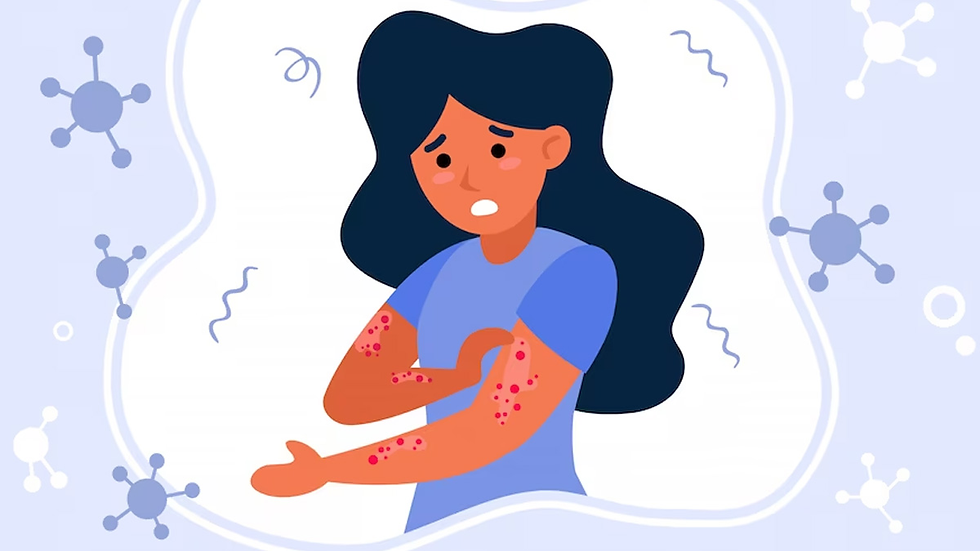Living with Lupus: Symptoms, Treatments, and Hope for the Future
- Alex Baek-Nadell
- Dec 14, 2024
- 3 min read

Introduction
Imagine waking up every day unsure of if your body will betray you. An unexplained rash, fever, or intense pain can manifest on any given day. This is a reality for the around 5 million people worldwide who have systemic lupus erythematosus (SLE). SLE is a chronic autoimmune disease that occurs when an individual’s immune system experiences a “ loss of self-tolerance”. This causes the immune system to attack the body's own tissues and cells. Central Tolerance Breakdown, genetic, and environmental factors all contribute to the manifestation of autoimmune disorders. SLE specifically can affect nearly every part of the body, from the skin and joints to vital organs like the kidneys and heart.
Despite its prevalence and seriousness, SLE remains poorly understood. Characterized by a wide variety of symptoms, SLE diagnosis is difficult and management is even more challenging. In this article, we’ll explore the symptoms of lupus, current treatment options, and ongoing efforts to improve care for those living with this complex disease.
Symptoms and Diagnosis
As mentioned, SLE can manifest in a multitude of ways. Symptoms include persistent fatigue, joint pain or swelling, skin rashes (most notably the butterfly-shaped rash across the cheeks and nose), fever, and sensitivity to sunlight. In more severe cases, lupus can lead to complications such as kidney inflammation (lupus nephritis), cardiovascular disease, and neurological symptoms like seizures or memory loss.
These symptoms are vast and mimic other diseases, making diagnosis particularly challenging. Diagnosing lupus typically involves a combination of clinical evaluation and laboratory tests. Physicians may look for physical symptoms, like rashes and swollen joints, while antinuclear antibody (ANA) are used to confirm an autoimmune response. Other tests, such as anti-dsDNA, anti-Smith antibodies, and complement levels, are also used to confirm the autoimmune disorder is SLE and can provide insights into disease activity and severity.
Current Treatments
Treating these wide varieties of symptoms poses a great challenge. Current therapies aim to manage symptoms rather than cure the disease. Treatment plans are highly individualized, as the severity and manifestations of lupus vary widely among patients.
Treatments often include nonsteroidal anti-inflammatory drugs to reduce joint pain and antimalarial drugs such as hydroxychloroquine to reduce disease flares. Corticosteroids are also commonly prescribed to suppress the immune response, though long-term use is associated with significant side effects. Immunosuppressants like azathioprine, mycophenolate mofetil, or cyclophosphamide are also used to dampen the immune system.
Advances and Challenges
Ongoing research is focusing on developing more personalized treatments for SLE. Trials for new biologics and immunotherapies are ongoing, aiming to provide an alternative for the side effect intensive current medications. Anifrolumab, which targets type I interferon receptors, have shown promise in reducing disease activity in lupus patients.
Managing and treating SLE still remains a large challenge. Disease flares can make long-term management difficult for patients. While effective in controlling inflammation, Corticosteroids are associated with complications like osteoporosis and diabetes. There is also a significant emotional toll associated with living with a chronic illness.
Conclusion
Intervention and early diagnosis of SLE are key for positive outcomes. Significant strides have been made in treatment, but the complex nature of SLE makes more research necessary. In the future, therapies may shift from symptom management to curing SLE. Biologics, immunotherapies, and personalized medicine bring the promise of more effective and less burdensome treatments. One day, SLE care may be transformed, and the quality of life for millions of patients worldwide with it.
Mayo Clinic. (n.d.). Lupus: Symptoms and causes. https://www.mayoclinic.org/diseases-conditions/lupus/symptoms-causes/syc-20365789
Lupus Foundation of America. (n.d.). Lupus facts and statistics. https://www.lupus.org/resources/lupus-facts-and-statistics
National Institute of Mental Health. (n.d.). Chronic illness & mental health. https://www.nimh.nih.gov/health/publications/chronic-illness-mental-health
SpringerLink. (2022). Current treatment of systemic lupus erythematosus: a clinician's perspective . Rheumatology International.
AstraZeneca. (2021). Saphnelo approved in the US for SLE. https://www.astrazeneca.com/media-centre/press-releases/2021/saphnelo-approved-in-the-us-for-sle.html#!
Better Health Channel. (n.d.). Hormones - cortisol and corticosteroids. https://www.betterhealth.vic.gov.au/health/conditionsandtreatments/Hormones-cortisol-and-corticosteroids
Johns Hopkins Lupus Center. (n.d.). Lupus blood tests.

